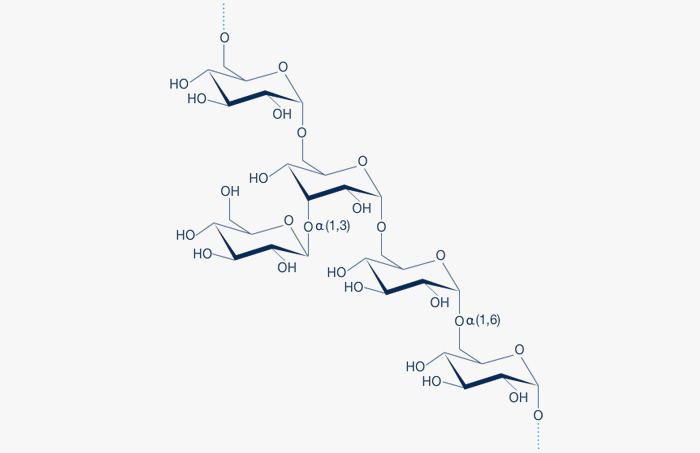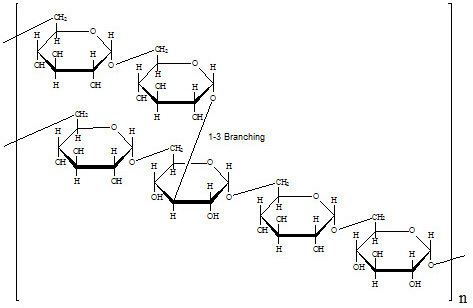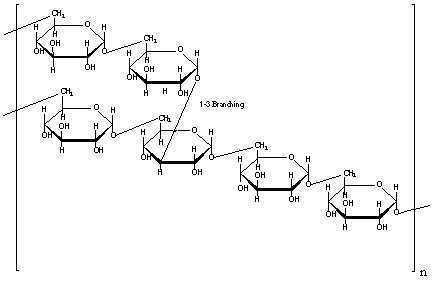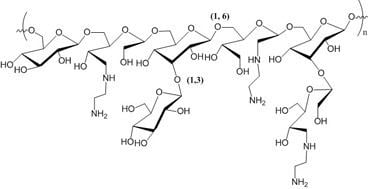Formula H(C6H10O5)xOH | ||
 | ||
Dextran is a complex branched glucan (polysaccharide made of many glucose molecules) composed of chains of varying lengths (from 3 to 2000 kilodaltons). It is used medicinally as an antithrombotic (antiplatelet), to reduce blood viscosity, and as a volume expander in hypovolaemia.
Contents

The straight chain consists of α-1,6 glycosidic linkages between glucose molecules, while branches begin from α-1,3 linkages. Dextran is synthesized from sucrose by certain lactic acid bacteria, the best-known being Leuconostoc mesenteroides and Streptococcus mutans. Dental plaque is rich in dextrans.

Dextran was first discovered by Louis Pasteur as a microbial product in wine. Dextran 70 is on the WHO Model List of Essential Medicines, the most important medications needed in a basic health system.

Microsurgery

These agents are used commonly by microsurgeons to decrease vascular thrombosis. The antithrombotic effect of dextran is mediated through its binding of erythrocytes, platelets, and vascular endothelium, increasing their electronegativity and thus reducing erythrocyte aggregation and platelet adhesiveness. Dextrans also reduce factor VIII-Ag Von Willebrand factor, thereby decreasing platelet function. Clots formed after administration of dextrans are more easily lysed due to an altered thrombus structure (more evenly distributed platelets with coarser fibrin). By inhibiting α-2 antiplasmin, dextran serves as a plasminogen activator, so possesses thrombolytic features.

Outside from these features, larger dextrans, which do not pass out of the vessels, are potent osmotic agents, thus have been used urgently to treat hypovolemia. The hemodilution caused by volume expansion with dextran use improves blood flow, thus further improving patency of microanastomoses and reducing thrombosis. Still, no difference has been detected in antithrombotic effectiveness in comparison of intra-arterial and intravenous administration of dextran.
Dextrans are available in multiple molecular weights ranging from 3,000 Da to 2,000,000 Da. The larger dextrans (>60,000 Da) are excreted poorly from the kidney, so remain in the blood for as long as weeks until they are metabolized. Consequently, they have prolonged antithrombotic and colloidal effects. In this family, dextran-40 (MW: 40,000 Da), has been the most popular member for anticoagulation therapy. Close to 70% of dextran-40 is excreted in urine within the first 24 hours after intravenous infusion, while the remaining 30% are retained for several more days.
Other medical uses
Laboratory uses
Side effects
Although relatively few side effects are associated with dextran use, these side effects can be very serious. These include anaphylaxis, volume overload, pulmonary edema, cerebral edema, or platelet dysfunction.
An uncommon but significant complication of dextran osmotic effect is acute renal failure. The pathogenesis of this renal failure is the subject of many debates with direct toxic effect on tubules and glomerulus versus intraluminal hyperviscosity being some of the proposed mechanisms. Patients with history of diabetes mellitus, renal insufficiency, or vascular disorders are most at risk. Brooks and others recommend the avoidance of dextran therapy in patients with chronic renal insufficiency.
